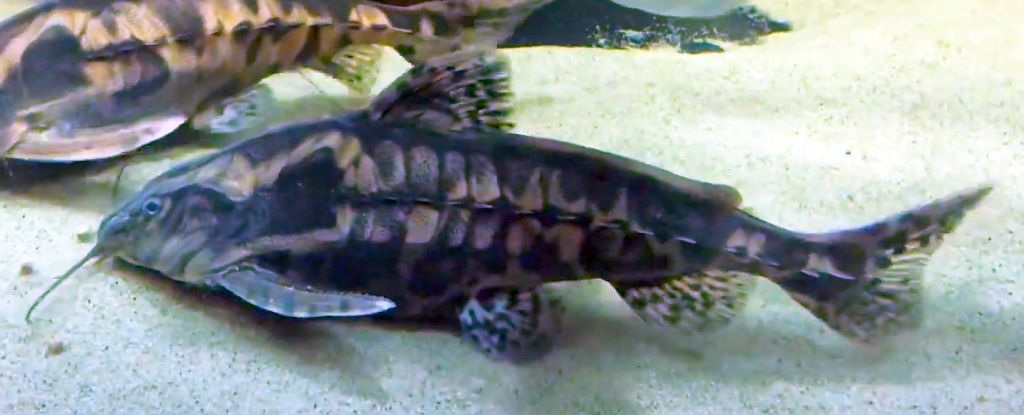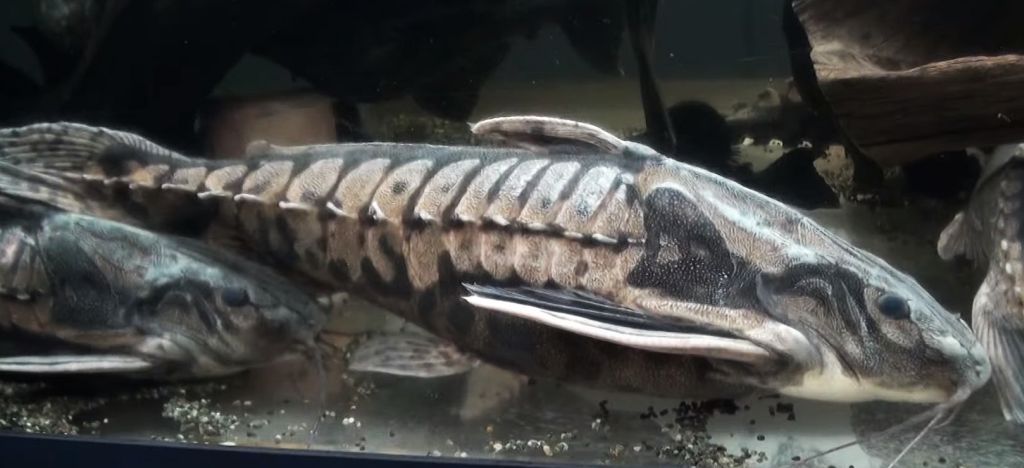The Giant Raphael Catfish (Megalodoras uranoscopus) also known to tropical fish keeping enthusiasts as the Giant Talking Catfish, Mother of Snails Catfish, Megalodoras Catfish, or Ripsaw Catfish, is a native to the Amazon River Basin in Bolivia, Brazil, Colombia, Ecuador and Peru.
Giant Raphael Catfish (Megalodoras uranoscopus) have been recorded in the Amazon, Essequibo, and Tocantins river systems and grow to a length of 28 inches or more.
Giant Raphael Catfish prefer slower moving creeks, swamps, river tributaries, and areas like Lake Hyanuary, close to the rainforest city of Manaus, Brazil, They are usually found hiding among tree roots and submerged vegetation but depending on the time of year, they can also be found in temporarily flooded areas and in the main river channels.
Although Giant Raphael Catfish occasionally form small schools, they prefer living in smaller groups. In the wild they feed on Licania longipetala and Astorcaryum jauari palm fruits and are particularly fond of pulmonate snails.
Although Giant Raphael Catfish have an attractive color pattern that remains with age, they are rarely imported for the aquarium trade. In their native range, they are a commercially harvested as a food fish.
Megalodoras uranoscopus is known for its ability to produce sounds by locking their spiny pectoral fins into their sockets, grinding them against the inner portion of the socket and resonating their swim bladder using a muscle in the back of their skull to produce a deep clicking sound.
Because of their large size, a single Giant Raphael Catfish should be housed in an aquarium with minimum dimensions of 4′ X 8′ with a bare or sandy substrate and large pieces of driftwood or a length of large diameter PVC pipe for them to hide. They are a shoaling diurnal species that require dim lighting and because of the copious amounts of waste they produce, a large, efficient, filtration system. High end canister filters or wet/dry filters
are a must for this species in order to maintain good water quality.
Giant Raphael Catfish are peaceful and do best when housed in groups of 4 or more specimens. They can be maintained in a large community aquarium with like sized doradids like Pseudodoras niger, Potamotrygon, Osteoglossum spp., larger loricariids, Rays, or characids like Myleus or Metynnis spp.
Megalodoras uranoscopus are easily sexed but have not been bred in an aquarium environment.
In their natural habitat, Giant Raphael Catfish eat snails and palm fruits that drop into the water. In an aquarium environment, they are not fussy eaters and will scavenge food from the bottom, but in order to maintain a healthy immune system, they need both meaty and plant based foods in their diet.
Commercially prepared sinking catfish pellets, earthworms, frozen bloodworms, prawns, snails, blanched vegetables, and vegetable wafer type foods will keep them healthy.
It’s best to feed them only 2 to 4 times a week and increase the amount and frequency as the fish grow. As the fish settle into their environment they will come to the surface to accept food.
Giant Raphael Catfish (Megalodoras uranoscopus) are occasionally available from importers online and specialty tropical fish shops in the United States as juveniles. Prices vary according to demand.
Minimum Tank Size: 180 gallons
Care Level: Moderate
Temperament: Peaceful
Aquarium Hardiness: Hardy
Water Conditions: 70-79° F, KH 0-25, pH 5.5-7.5
Max. Size: 28″
Color Form: Brown, Black, White, Gold
Diet: Omnivore
Compatibility: Good community tank fish
Origin: Brazil, Peru, Columbia, Bolivia
Family: Doradidae
Live Span: 5 to 20 years
Aquarist Experience Level: Experienced




